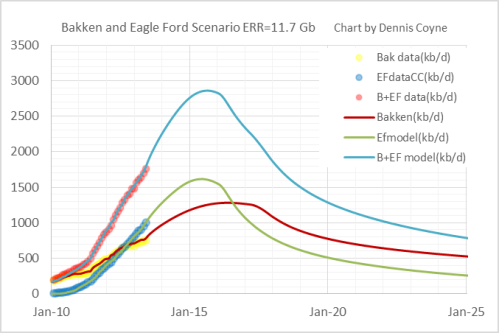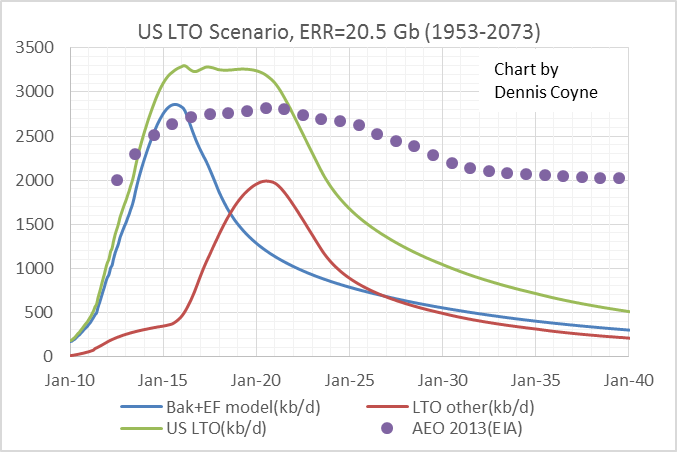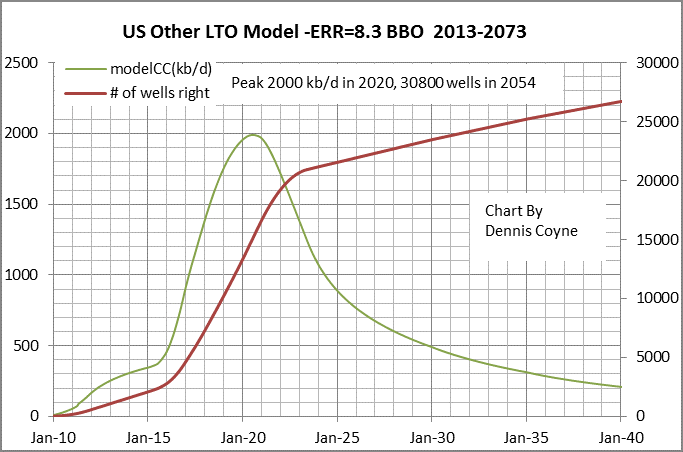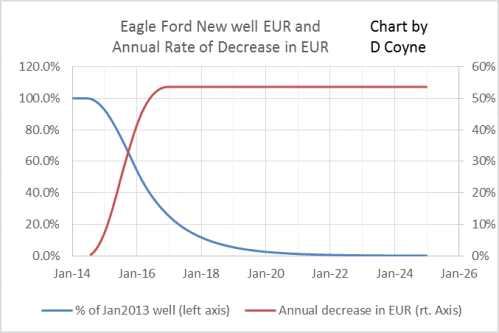Home » Posts tagged 'LTO'
Tag Archives: LTO
peak oil climate and sustainability: When will US LTO(light tight oil) Peak?
peak oil climate and sustainability: When will US LTO(light tight oil) Peak?.
The rapid rise in oil output since 2008 has the mainstream media claiming that the US will soon be energy independent. US Crude oil output has increased about 2.8 MMb/d (56%) since 2008 and about 2 MMb/d is from the shale plays in North Dakota ( Bakken/Three Forks) and Texas (Eagle Ford). My modeling suggests that a peak from these two plays may be reached by 2016, other shale plays (also known as light tight oil [LTO] plays) may be able to fill the gap left by declining Bakken and Eagle Ford output until 2020, beyond that point we will see a rapid decline.
| US Light Tight Oil to 2040 |
There are two main views:
-
There will be little crude plus condensate (C+C) output from any plays except the Bakken/Three Forks in North Dakota and Montana and the Eagle Ford of Texas.
-
The other LTO plays will come to the rescue when the Bakken and Eagle Ford reach their peak and keep LTO near these peak levels to about 2020 with a slow decline in output out to 2040.
Where are these “other LTO plays”? There are a couple of these in Oklahoma and Texas (in the Permian basin, Granite Wash, Mississippian basin), the Appalachian, the Niobrara in Colorado, and others (see slide 17 of the USGS presentation link below). Is it possible for these LTO plays to offset future declines in the Bakken and Eagle Ford? I hope to answer that in this post.
When doing my modeling of the Eagle Ford, I needed an estimate of the technically recoverable resource(TRR) for that play. The April 2013 USGS Bakken Three Forks Assessment roughly doubled their earlier assessment of that play (mostly this was due to not including the Three Forks in their earlier assessment.)
see slide 17 at the USGS Bakken/Three Forks Assessment presentation.
In light of this I decided to increase the earlier (1.73 Gb) Eagle Ford estimate of undiscovered technically recoverable resources(TRR) from the USGS by a factor of 2.3 to 4 Gb. To determine total TRR, the proved reserves and oil already produced need to be added to the undiscovered TRR, in the case of the Eagle Ford output to the end of 2011 was only 0.1 Gb and proved reserves were about 1 Gb (check the EIA data on the change in proved reserves since 2009 in districts 1 and district 2 of Texas):
So for the Eagle Ford estimated TRR would be 4+1=5 Gb.
For the North Dakota Bakken undiscovered TRR is 5.8 Gb, 2.2 Gb of proven reserves, and 0.5 Gb of oil produced for a Total TRR of 8.5 Gb. See my previous post for more details.
For the rest of the US we can deduct Bakken (7.38 Gb), Eagle Ford(1.73 Gb), and Alaska(0.94 Gb) from the US total (13 Gb) which leaves about 3 Gb, now assume that a reassessment by the USGS increases this by a factor of 2.3 to 7.2 Gb, then add the Montana Bakken/Three Forks (1.6 Gb) and reserves from the Permian basin and other plays (1.3 Gb) to get 9.2 Gb for a TRR estimate for US “other LTO”(Total LTO minus [North Dakota Bakken/Three Forks plus Eagle Ford play]). Total TRR for all US LTO is 22.7 Gb. (I have assumed LTO from Alaska’s North Slope will not be produced.)
For the North Dakota Bakken/Three Forks and Eagle Ford plays we use the following economic assumptions to find the Economically Recoverable Resource (ERR):
OPEX (operating expenditure) is $4/barrel, royalty and tax payments are 24.5 % of wellhead revenue, annual discount rate is 12 % (used to find the net present value[NPV] of a well over its 30 year life). Transport costs are $12/barrel for the Bakken and $3/barrel for the Eagle Ford. Well costs are 9 million for the Bakken in Jan 2013 and fall by 8% per year to 7 million in 2016 and for the Eagle Ford well costs are $8 million in Jan 2013 and fall 8% per year to $6.5 million in mid 2017. Real oil prices follow the EIA’s 2013 Annual Energy Outlook reference case to 2040 and then continue to rise at the 2030 to 2040 rate to the end of the scenario. All costs and prices are in May 2013$ so they are real prices rather than nominal prices.
The concept of ERR is discussed in detail in the Sept, 2013 post after figure 3.
Figure 1

I will use the Eagle Ford play as my template because it has ramped up much more quickly than the Bakken, this is a very optimistic scenario and it is unlikely that there will be greater output from US LTO than the scenario I will present.
The underlying assumptions are:
-the average well will look like the average Eagle Ford well
-ramp up of additional wells will be slow until the peak of combined Bakken and Eagle Ford output
-in 2015 the Bakken and Eagle Ford peak and reach break even levels of profitability by 2016
-in response to reaching break even the number of new wells per month added in both the ND (North Dakota) Bakken and the Eagle Ford are reduced substantially.
-new wells added in the other US LTO plays ramp up as the rate that wells added to the Bakken and EF are reduced
As before we adjust the decrease in new well EUR (both when it begins and how long it takes to reach its maximum) so that the TRR matches our estimate of 9.2 Gb. In this case the EUR starts to decrease in July 2018 and reaches its maximum monthly rate of decrease of 2.37 % in June 2020. The “other LTO” peaks in 2020 at about 2 MMb/d.
To determine ERR we make identical economic assumptions as our Eagle Ford case above except that we assume transport costs are $5/barrel on average ($3/barrel in EF case).
Figure 2
When we combine our North Dakota Bakken/Three Forks, Eagle Ford, and “other LTO” models we get the following chart:
| Figure 3 |
This scenario is indeed optimistic, but not nearly as optimistic as the EIA’s scenario for LTO in the 2013 Annual Energy Outlook. For comparison I computed the ERR for 2013 to 2040 for my US LTO scenario, it was 17.6 Gb over that period, the EIA scenario has a total output of 24.5 Gb over the same period, 40% higher output than an already optimistic scenario. My guess is that reality will lie between the blue curve and the green curve with the most likely peak around 2018+/- 2 years at about 3.1+/- 0.2 MMb/d.
Dennis Coyne
Appendix Bakken and Eagle Ford Details
I am still working on this section, check back for details
I am still working on this section, check back for details
Using the USGS TRR estimates as our guide we assume new well estimated ultimate recovery (EUR) eventually decreases as the room for new wells in the most productive areas (the sweet spots) starts to run out. If new wells are producing an average of 450 kb over 30 years before this decrease begins, we assume at some point, say June 2014 the new well EUR starts to decrease maybe by 0.4% per month, the rate of decrease continues to increase for 18 months so that after 18 months the new well EUR is decreasing at a monthy rate of 7.2 %.






